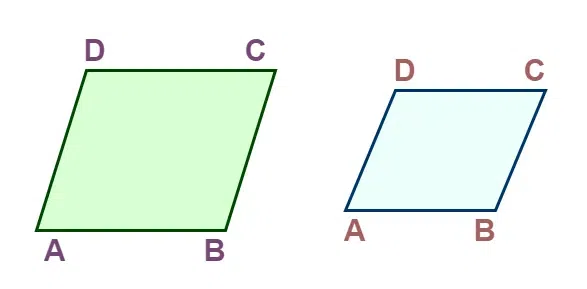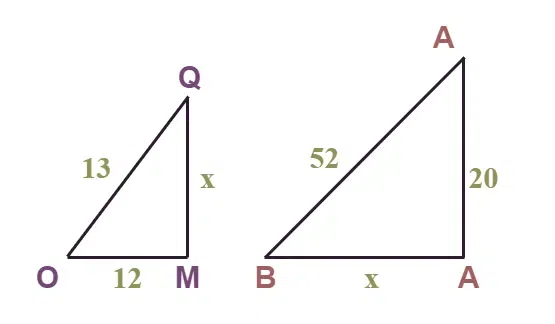Similar figures are two figures having the same shape. Similar figures can or can not have the same area. Congruent shapes are the shapes that are the same with the same areas.
In this article, we will learn about, similar figures, properties of similar figures, related examples and others in detail.
What is Similarity in Maths?
A similarity in maths occurs when two or more items or figures appear to have the same or equal shape. These figures always overlap regardless of how much we enlarge or reduce them. Whereas, If the objects are the same Comparatively speaking, analogous objects have proportionate corresponding sides and corresponding angles of equal measure.
When two figures have the same shape but differ in size, they are said to be similar figures. Even though these figures are considered comparable when they share many characteristics they are not necessarily the same.
We say that, if two figures are similar then twe use ‘∼’ symbols to represents these figures. Let us say there are two triangles, ABC and LMN, which are similar, then they are represented as;
∆ABC ~ ∆ LMN
Now if the two triangles are similar to each then their corresponding sides are in proportion, i.e.
- AB/LM = BC/MN = AC/LN
- ∠A = ∠L, ∠B = ∠M, ∠C = ∠N
In mathematics, the properties are essential for recognizing and manipulating any two Similar figures together;
Corresponding Angles
When the measurements of the angles in one figure matched with the other figure. Alternatively, the angles in one figure coincide with the angles in the other figure.
For Example: The quadrilaterals ABCD and EFGH are given below;

Corresponding Angles in Similar Figures
where:
- A corresponds to angle E
- B corresponds to angle F
- C corresponds to angle G
- D corresponds to angle H
Proportional Side Lengths
There is equality in the ratios of the corresponding side lengths. This implies that any pair of corresponding sides from any of the two figures can be used to create a ratio. Therefore, the ratio will always be the same.
For Example: We can use the same figure given above in the example of Corresponding angles.
AB/EF = BC/FG = CD/GH = AD/EH (Ratios of Corresponding Sides)
Scale Factor
The ratio of the lengths of the corresponding sides of two comparable shapes is known as the scale factor that is used to describe the size of the original figure compared to the size of its related image with an enlargement, contraction, or dilation.
How to Calculate Scale Factor
While calculating, the scale factor can be greater than 1 in enlargement, If less than 1 is contraction, or equal to 1 then there will be no change in the size.
So, if we have two similar figures, we can use the formula of the scale factor (k) to looking how it can be calculated;
- k = Length of the corresponding side in image/Length of the corresponding side in original.
For Example: Let’s look after the similar rectangles in the situation given below by using the formula of scale factor;
- Original recatngle with dimensional length is 6 units and width is 4 units.
- Similar rectangle with dimensional length is 12 units and width is 8 units.
By using the formula, k = Length of the corresponding side in image/Length of the corresponding side in original.
Therefore, We can determine that the scale factor k for this transformation is 2, as the scale factor for both length and width is the same.
Similarity for Triangle
If the sides of two triangles have the same ratio or percentage that means they are corresponding sides and the angles are equal that means they are corresponding angles, then the triangles are similar. Triangles that are similar to one another may have varying side lengths individually, but they must have equal angles and the same scale factor, or ratio, between their side lengths. If two triangles resemble one other.
- Every triangle’s associated angle pair is equal.
- Triangles have all of their matching sides in the same proportion.
Let’s examine how triangles and the three theorems relate to each other in terms of angles and sides.
Angle-Angle (AA) Criterion
In this term, If two pairs of corresponding angles in a pair of triangles are congruent, then the two triangles are similar.
.webp)
Angle-Angle (AA) Criterion
Side-Side-Side (SSS) Criterion
Two triangles are congruent if the three sides of a triangle are equal to the corresponding three sides of the other triangle.
Two triangles are given below ABC = DEF such that AB = DE, BC = EF, and AC = DF.
.webp)
Side-Side-Side (SSS) Criterion
Side-Angle-Side (SAS) Criterion
Two triangles are congruent if two sides and the included angle of one are equal to the corresponding sides and the included angle of the other triangle.
Two triangles are given below ABC congruent to DEF such that ∠ BAC = ∠DEF and AB = DE, AC = DF.
.webp)
Side-Angle-Side (SAS) Criterion
Real-World Examples
We benefit from knowing the links between similar figures and how they function in both geometry and real-world applications. The most often used application of similar figures is an estimating the size of a larger, from the smallest figure.
For Example: Let us assume we have a map of a city where a real mile is represented by 1 inch on the map. There seems to be a road on this map that is 3 inches long. Using the scale factor, we wish to calculate the true length of this road.
- On Map Scale , 1 inch is equal to 1 real mile.
Length of road on the map is 3 inches. True length of the road is calculated as:
Now, substituting the values:
True Length of Road = 3 inches × 1 mile/inch = 3 miles
The following lists a few uses for resemblance or figures that are comparable.
- In architecture, the similarity is frequently used.
- Distance and height are involved in issue-solving.
- Resolving triangle-related mathematical puzzles.
- Geometric objects that are similar in shape bfigureshing sides and angles are proportionate and congruent.
Example 1: In the Δ ABC length of the sides is given as AP = 4 cm, PB = 12 cm, and BC = 20 cm. Also PQ||BC. Find PQ.

Solution:
In ΔABC and ΔAPQ, ∠PAQ is common and ∠APQ = ∠ABC (corresponding angles).
⇒ ΔABC ~ ΔAPQ (AA criterion for similar triangles)
⇒ AP/AB = PQ/BC
⇒ 4/12 = PQ/20
⇒ 3 = PQ/20
⇒ PQ = 20/3 cm
Example 2: If the following figures are similar, Find the value of x.

Solution:
5/20 = 12/x = 13/52
5×x = 20×12
5x = 240
5x/5 = 240/5
x = 48
Ques 1: In the ΔABC length of the sides is given as AP = 8 cm, PB = 20 cm, and BC = 9 cm. Also PQ||BC. Find PQ.
Ques 2: In the ΔABC length of the sides is given as AP = 12 cm, PB = 30 cm, and BC = 10 cm. Also PQ||BC. Find PQ.
What are similar triangles?
If two triangles have an identical pair of corresponding angles and the same ratio of corresponding sides, they are said to be similar triangles.
What are examples of similar figures.
Examples of two similar figures are;
- Any of the two similar triangle.
- Any of the two similar rectangle.
How is Similarity Used in Real Life?
Similarity is applied in designing, problem-solving, height-distance, etc.
How is similarity used in real-life?
Similarity are used in various ascepts of real-life like in designing, solving problems involving height and distance, etc.
What is a Side-Side-Side (SSS) Criterion ?
SSS similarity criterion is a similarity between two triangles and if their three sides are proportionate to each other.
What are congruent figures?
Congruent figures are the figures that are exactly the same. These figures can be directly overlapped to each other.
Share your thoughts in the comments
Please Login to comment...